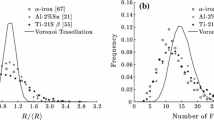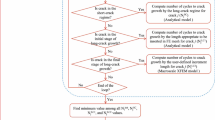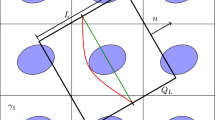Abstract
In this contribution we present a gradient enhanced damage based method to simulate discrete crack propagation in 3D polycrystalline microstructures. Discrete cracks are represented using the eXtended finite element method. The crack propagation criterion and the crack propagation direction for each point along the crack front line is based on the gradient enhanced damage variable. This approach requires the solution of a coupled problem for the balance of momentum and the additional global equation for the gradient enhanced damage field. To capture the discontinuity of the displacements as well as the gradient enhanced damage along the discrete crack, both fields are enriched using the XFEM in combination with level sets. Knowing the crack front velocity, level set methods are used to compute the updated crack geometry after each crack propagation step. The applied material model is a crystal plasticity model often used for polycrystalline microstructures of metals in combination with the gradient enhanced damage model. Due to the inelastic material behaviour after each discrete crack propagation step a projection of the internal variables from the old to the new crack configuration is required. Since for arbitrary crack geometries ill-conditioning of the equation system may occur due to (near) linear dependencies between standard and enriched degrees of freedom, an XFEM stabilisation technique based on a singular value decomposition of the element stiffness matrix is proposed. The performance of the presented methodology to capture crack propagation in polycrystalline microstructures is demonstrated with a number of numerical examples.



















Similar content being viewed by others
References
Asaro RJ (1983) Crystal plasticity. J Appl Mech 50(4b):921–934
Babuška I, Banerjee U (2012) Stable generalized finite element method (SGFEM). Comput Methods Appl Mech Eng 201–204:91–111
Barth TJ, Sethian JA (1998) Numerical schemes for the hamilton–jacobi and level set equations on triangulated domains. J Comput Phys 145(1):1–40
Bažant Z, Pijaudier-Cabot G (1988) Nonlocal damage, localization instability and convergence. J Appl Mech 55:287–293
Béchet E, Minnebo H, Moës N, Burgardt B (2005) Improved implementation and robustness study of the X-FEM for stress analysis around cracks. Int J Numer Methods Eng 64:1033–1056
Beese S, Loehnert S, Wriggers P (2016) Modeling of fracture in polycrystalline materials. In: Advances in discretization methods, Springer, pp 79–102
Belytschko T, Black T (1999) Elastic crack growth in finite elements with minimal remeshing. Int J Numer Methods Eng 45:601–620
Belytschko T, Moës N, Usui S, Parimi C (2001) Arbitrary discontinuities in finite elements. Int J Numer Methods Eng 50:993–1013
Bertram A (1999) An alternative approach to finite plasticity based on material isomorphisms. Int J Plast 15(3):353–374
Chopp DL, Sukumar N (2003) Fatigue crack propagation of multiple coplanar cracks with the coupled extended finite element/fast marching method. Int J Eng Sci 41:845–869
Duarte CA, Hamzeh ON, Liszka TJ, Tworzydlo WW (2001) A generalized finite element method for the simulation of three-dimensional dynamic crack propagation. Comput Methods Appl Mech Eng 190:2227–2262
Duflot M (2007) A study of the representation of cracks with level sets. Int J Numer Methods Eng 70:1261–1302
Elguedj T, Gravouil A, Combescure A (2006) Appropriate extended functions for X-FEM simulation of plastic fracture mechanics. Comput Methods Appl Mech Eng 195:501–515
Erdogan F, Sih G (1963) On the crack extension in plates under plane loading and transverse shear. J Basic Eng 85:519–525
Eringen AC, Suhubi E (1964) Nonlinear theory of simple micro-elastic solids i. Int J Eng Sci 2(2):189–203
Farhat C, Roux FX (1991) A method of finite element tearing and interconnecting and its parallel solution algorithm. Int J Numer Methods Eng 32:1205–1227
Fries TP (2008) A corrected XFEM approximation without problems in blending elements. Int J Numer Methods Eng 75:503–532
Fries TP, Baydoun M (2012) Crack propagation with the extended finite element method and a hybrid explicit–implicit crack description. Int J Numer Methods Eng 89:1527–1558
Garzon J, O’Hara P, Duarte CA, Buttlar WG (2014) Improvements of explicit crack surface representation and update within the generalized finite element method with application to three-dimensional crack coalescence. Int J Numer Methods Eng 97(4):231–273
Gravouil A, Moës N, Belytschko T (2002) Non-planar 3D crack growth by the extended finite element and level sets—part II: level set update. Int J Numer Methods Eng 53:2569–2586
Griffith AA (1921) The phenomena of rupture and flow in solids. Philos Trans R Soc Lond A 221:163–198
Gupta P, Duarte CA (2014) Simulation of non-planar three-dimensional hydraulic fracture propagation. Int J Numer Anal Methods Geomech 38(13):1397–1430
Gupta V, Duarte CA, Babuška I, Banerjee U (2013) A stable and optimally convergent generalized FEM (SGFEM) for linear elastic fracture mechanics. Comput Methods Appl Mech Eng 266:23–39
Helm D (2006) Stress computation in finite thermoviscoplasticity. Int J Plast 22(9):1699–1727
Holl M, Rogge T, Loehnert S, Wriggers P, Rolfes R (2014) 3D multiscale crack propagation using the XFEM applied to a gas turbine blade. Comput Mech 53(1):173–188
Hughes TJ, Franca LP, Hulbert GM (1989) A new finite element formulation for computational fluid dynamics: Viii. the galerkin/least-squares method for advective–diffusive equations. Comput Methods Appl Mech Eng 73(2):173–189
Kachanov L (1958) Time of the rupture process under creep conditions. Isv Akad Nauk SSR Otd Tekh Nauk 8:26–31
Laborde P, Pommier J, Renard Y, Salaün M (2005) High-order extended finite element method for cracked domains. Int J Numer Methods Eng 64:354–381
Legrain G, Moës N, Verron E (2005) Stress analysis around crack tips in finite strain problems using the extended finite element method. Int J Numer Methods Eng 63:290–314
Loehnert S (2014) A stabilization technique for the regularization of nearly singular extended finite elements. Comput Mech 54:523–533
Loehnert S, Mueller-Hoeppe DS, Wriggers P (2011) 3D corrected XFEM approach and extension to finite deformation theory. Int J Numer Methods Eng 86:431–452
Mazars J, Pijaudier-Cabot G (1996) From damage to fracture mechanics and conversely: a combined approach. Int J Solids Struct 33:3327–3342
Menk A, Bordas SPA (2011) A robust preconditioning technique for the extended finite element method. Int J Numer Methods Eng 85:1609–1632
Moës N, Belytschko T (2002) Extended finite element method for cohesive crack growth. Eng Fract Mech 69:813–833
Moës N, Dolbow J, Belytschko T (1999) A finite element method for crack growth without remeshing. Int J Numer Methods Eng 46:131–150
Moës N, Gravouil A, Belytschko T (2002) Non-planar 3D crack growth by the extended finite element and level sets—part I: mechanical model. Int J Numer Methods Eng 53:2549–2568
Oliver J, Huespe AE (2004) Continuum approach to material failure in strong discontinuity settings. Comput Methods Appl Mech Eng 193:3195–3220
Peerlings R, de Borst R, Brekelmans W, de Vree J (1996) Gradient enhanced damage for quasi-brittle materials. Int J Numer Methods Eng 39:3391–3403
Pereira JP, Duarte CA, Guoy D, Jiao X (2009) hp-generalized fem and crack surface representation for non-planar 3-d cracks. Int J Numer Methods Eng 77(5):601–633
Perić D, Vaz M, Owen D (1999) On adaptive strategies for large deformations of elasto-plastic solids at finite strains: computational issues and industrial applications. Comput Methods Appl Mech Eng 176(1):279–312
Pietruszczak S, Mróz Z (1981) Finite element analysis of deformation of strain-softening materials. Int J Numer Methods Eng 17(3):327–334
Ramasubramaniam A, Ariza M, Ortiz M (2007) A discrete mechanics approach to dislocation dynamics in bcc crystals. J Mech Phys Solids 55(3):615–647
Sauerland H, Fries TP (2013) The stable XFEM for two-phase flows. Comput Fluids 87:41–49
Sethian J (1996) A fast marching level set method for monotonically advancing fronts. Proc Natl Acad Sci 93:1591–1595
Sethian JA, Vladimirsky A (2000) Fast methods for the eikonal and related hamilton–jacobi equations on unstructured meshes. Proc Natl Acad Sci 97(11):5699–5703
Simo JC (1987) On a fully three-dimensional finite-strain viscoelastic damage model: formulation and computational aspects. Comput Methods Appl Mech Eng 60(2):153–173
Steinmann P, Stein E (1996) On the numerical treatment and analysis of finite deformation ductile single crystal plasticity. Comput Methods Appl Mech Eng 129(3):235–254
Stolarska M, Chopp LD, Moës N, Belytschko T (2001) Modelling crack growth by level sets in the extended finite element method. Int J Numer Methods Eng 51:943–960
Strouboulis T, Babuška I, Copps K (2000) The design and analysis of the generalized finite element method. Comput Methods Appl Mech Eng 181:43–69
Sukumar N, Chopp DL, Moran B (2003) Extended finite element method and fast marching method for three-dimensional fatique crack propagation. Eng Fract Mech 70:29–48
Sukumar N, Moës N, Moran B, Belytschko T (2000) Extended finite element method for three-dimensional crack modelling. Int J Numer Methods Eng 48:1549–1570
Svendsen B (1998) A thermodynamic formulation of finite-deformation elastoplasticity with hardening based on the concept of material isomorphism. Int J Plast 14(6):473–488
Acknowledgements
The support of the German Research Foundation (DFG) within the framework of the Grant SFB TR 73 is gratefully acknowledged.
Author information
Authors and Affiliations
Corresponding author
Rights and permissions
About this article
Cite this article
Beese, S., Loehnert, S. & Wriggers, P. 3D ductile crack propagation within a polycrystalline microstructure using XFEM. Comput Mech 61, 71–88 (2018). https://doi.org/10.1007/s00466-017-1427-y
Received:
Accepted:
Published:
Issue Date:
DOI: https://doi.org/10.1007/s00466-017-1427-y




